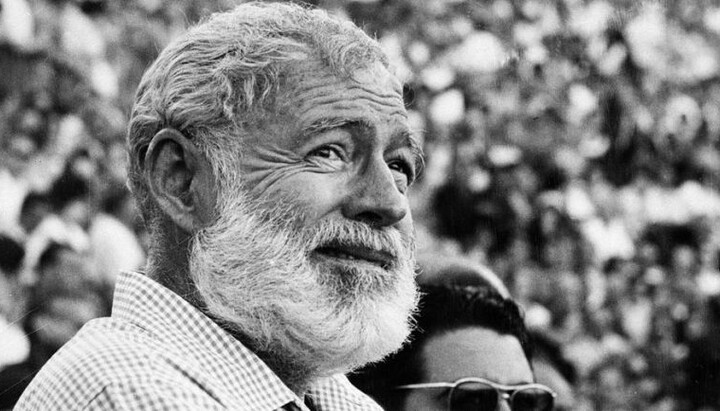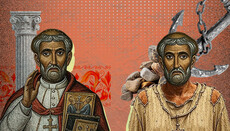Ernest Hemingway: The strange fates of his kin and his search for God

Ernest Hemingway was born on July 21, 1899.
The Old Man and the Sea is a remarkable novella. Each of us has our own sea of life, and within each of us lives a weary old man. The fisherman Santiago reminds me of the biblical Job. “Can you pull in Leviathan with a fishhook or tie down its tongue with a rope?” (Job 41:1), God asks the righteous sufferer. How can one draw to shore that which lies hidden in the depths of Your, O Lord, design for the world? How can one comprehend that which is both glorious and terrifying, which You permit to unfold on earth?
Long ago, while studying at the university's philology faculty, I began to wonder why the fates of Ernest Hemingway’s relatives unfolded so tragically. There is no clear answer. Some of it may be attributed to heredity, but not all. One way or another, fate crucified not only Hemingway himself, but many of those close to him.
There exists a form of depression that is incompatible with life. The soul simply cannot bear it. If you place a weight of several tons on a person’s shoulders, it will crush them no matter how hard they try to stay standing. Such is the burden of this severe form of depression. Ernest could not endure the weight of his illness and ended his suffering with a shot from his beloved shotgun. Before that, he had undergone thirteen rounds of electroshock therapy, which left him partially without memory and unable to write.
“You can’t crush genes with your finger,” says a folk proverb. Hemingway’s father ended his life in the very same way. Ernest’s younger brother Lester also died by a gunshot to the temple. But the chain of tragedies among Hemingway’s descendants does not end there.
The writer’s granddaughter, the exquisite beauty Margaux Hemingway, inherited not only her grandfather’s charismatic nature but also chronic depression, compounded by epileptic seizures. This bouquet of afflictions led to everything else: alcoholism, drug addiction, bulimia. At just shy of forty-two, Margaux took her own life with a fatal dose of pills.
Hemingway was married four times. The story of his son Gregory, from his second marriage, resembles a horror film more than a biography.
He repeated his father’s life almost exactly – but multiplied its pain and suffering many times over.
Like his father, Gregory was married four times. He too suffered from alcoholism and depression, with the addition of bipolar disorder and a dependence on psychotropic substances. But even that wasn’t all. Gregory spent his entire life tormented by gender dysphoria. He believed himself to be a woman, called himself Gloria, and planned to undergo gender reassignment surgery. This transition lasted until his death. He underwent breast augmentation, later removed the implant, and alternated between men’s and women’s clothing. Two days before his death, he was arrested for indecent behavior and died in a women’s detention center. This sorrowful story spanned sixty-nine years.
It is also worth noting that Ernest Hemingway may have driven his second wife Pauline, Gregory’s mother, to her death. After Gregory’s first arrest for drug possession, Hemingway called her and, in extremely harsh terms, blamed her for all the family’s misfortunes. A few hours later, Pauline died in intensive care – she suffered from a rare adrenal tumor that triggered a fatal surge of adrenaline during stress.
These misfortunes in the writer’s family can be explained by genetics, but strangely enough, Hemingway’s third wife, Martha Gellhorn, also followed his example. Though her marriage to Ernest was neither her first nor her last, she too ended her life by suicide – by cyanide capsule.
Ernest Hemingway’s personal life was tragic. He replaced each of his wives according to the same pattern. He married his first wife, Hadley Richardson, in 1921. After five years, she discovered his affair with Pauline, and they agreed to divorce in November 1926. In January 1927, Hemingway married Pauline. She, too, discovered an affair – this time with Martha Gellhorn – and they divorced in 1940. That same year, he married Martha.
His third wife left him in 1945. But before that, in May 1944, Hemingway met Mary Welsh. Stopping at her café table, he said: “I don’t know you at all. But I want to marry you. You’re so alive! You’re so beautiful. I want to marry you right now. And someday you’ll want to marry me. Just remember – I’ll marry you. Today, or tomorrow, or in a month, or in a year.”
Mary had already been married twice. A year later, she divorced in order to marry Hemingway in March 1945. Between his four marriages, Hemingway had not a single year of respite. They followed one another like parts on an assembly line. The marriages lasted five, thirteen, five, and sixteen years, respectively. The last did not end in divorce, but in suicide.
Throughout his life, Hemingway was drawn to all things “masculine,” yet never came close to believing in God.
“Thinking people are all atheists,” one of his characters proclaims – a line that explains much about Hemingway himself.
And yet all of his protagonists are fighters for humanism and resolute champions of good. For Hemingway, the ideal man resembles a samurai or kamikaze, doomed to die. His men lose – to women, to nature, to death – but they lose with courage and heroism.
Though Hemingway did not believe in God, for him evil was still sin. “Whether God exists or not, killing is still a sin” (For Whom the Bell Tolls). Hemingway was consistently anti-war. “I think that anyone who profits from war, or helps provoke it, should be shot on the first day of hostilities” (A Farewell to Arms). “The only people who love war are speculators, generals, desk rats, and prostitutes.”
As often happens, great writers surpass themselves in their work. Ernest the man and Hemingway the writer are not the same. The same could be said of Leo Tolstoy, Fyodor Dostoevsky, and other authors.
Hemingway’s characters are always faithful to the good, though they see the world plunging headlong into evil and no longer believe in the triumph of good. Yet they are ready to die for it, bravely and without regret. In the anti-war novels of Hemingway, one idea runs like a red thread: good cannot be fashioned out of evil. For evil always begets only more evil, and nothing else.
Alexander Galich once described it in a poem:
So, let us start – with blessings said...
A hundred years have passed – or sped –
A sloven prince, in silken gown,
Let filth and muck infest his crown,
So much, it made himself upset,
And filled his heart with deep regret.
In rage, he summoned forth a man –
A painter, wielding brush and can:
“Is it not time,” the prince did say,
“To paint this filth and wash away?”
The painter bowed: “Indeed, my lord,
Long overdue – upon my word.”
So filth turned dirty white and gray,
Then dirty yellow, blue, and clay,
As stroke by stroke, the painter passed
And cloaked the grime in hues amassed.
But filth is filth – it will remain,
No matter what the shades or stain.
Hemingway sensed this deeply. His characters are never deceived by evil, even when it is wrapped in the packaging of good.
Though he did not know God, and never even tried to seek Him, Ernest – perhaps unknowingly – poured into the anguished thoughts of his characters a great longing for God.
Each one of them harbors a thirst for love and the hope that, though good always seems to lose to evil, perhaps one day it may yet prevail.
Whatever the fate of this great writer may be after death, I know that through his work, he sowed good seeds upon the earth. And they, like an unceasing prayer, will intercede until the end of time, that his soul may find great peace. As the old fisherman Santiago said: “I wish it really had been a dream. But who knows? It might still turn out well.”
Indeed: “It’s foolish to lose hope…”












